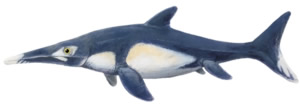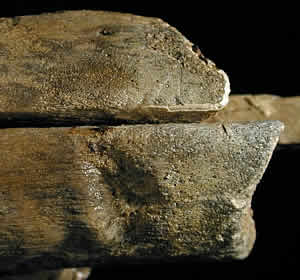
Reconstruction of a an ichthyosaur. credit Josh Lee

Ichthyosaur bite marks. A close-up of the ichthyosaur snout showing the healed wounds. credit Jo Bain, South Australian Museum
Scars on the jaw of a 120 million year old marine reptile suggest that life might not have been easy in the ancient polar oceans. The healed bite wounds were probably made by a member of the same species. Such injuries give important clues about the social behavior of extinct sea creatures from the time of dinosaurs. The find is described in a forthcoming issue of Acta Palaeontologica Polonica.
Found in the remote desert near the town of Marree in northern South Australia, the fossilized skeleton belonged to an ichthyosaur, a dolphin-like marine reptile that lived during the 'Age of Dinosaurs'. Ichthyosaurs were fast swimming predators that fed on fish and squid-like animals. Adults would have been around six meters in length and had long-snouted heads with over 100 pointed, crocodile-like teeth.
When the ichthyosaur was alive, the Australian continent was still joined to Antarctica and would have been much further south than it is today close to the southern polar circle. What is now arid grassland was then the bottom of a vast inland sea that experienced freezing water temperatures and even seasonal icebergs.
The surprising discovery of well preserved bite marks on the bones of the ichthyosaur's lower jaw were made during painstaking cleaning and reassembly of its skeleton in the laboratory. Evidence of advanced healing indicates that the animal survived the attack and lived on for some time afterwards.
"Pathological traces on ancient fossilized bones and teeth give unique insights into the lives and social behaviors of extinct animals" says Benjamin Kear, one of the authors of the study and an Assistant Professor with the Palaeobiology Programme at Uppsala University. "Such finds have also rarely been reported in ichthyosaurs before".
The size and spacing of the tooth marks do match any potential predators or prey. Rather, they are most consistent with another adult ichthyosaur, suggesting that the wounds were inflicted during combat over food, mates or territory. Facial biting is a common social interaction observed in animals today and is often directed towards restraining the opponents jaws.
